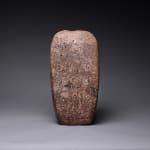Mayan Stone Ceremonial Celt, 500 CE - 900 CE
Stone
height 38.1 cm
height 15 in
height 15 in
PF.4697
Further images
The imagery on this magnificent celt is a stunning example of Maya iconography and masterful line drawing. Both elements, combined with the meaning of the narrative, designate this celt as...
The imagery on this magnificent celt is a stunning example of Maya iconography and masterful line drawing. Both elements, combined with the meaning of the narrative, designate this celt as an important record of a Maya ritual. And few rituals were as significant as the bloodletting ceremony. The surface of the stone is divided into two sections, the upper being somewhat smaller than the lower. This demarcation is important in separating the individuals, and clearly delineating the distinction between a different time and space. The two figures in the bottom register are in a seated position, each one holding their erect penises. The figure on the left wears a mask, and is confronted by a smaller zoomorphic mask suspended from the central hanging ornamentation. The upper figure, which wears an elaborate costume, crawls along the center border. He appears to be stalking-- his eyes stare intently, his mouth open wide, while he waits, listens and watches. It is likely we are witnessing a bloodletting ceremony performed by a king or high priest. The Maya believed the letting of blood was an act of piety and essential to the proper working of the universe. Men would pierce their penises and allow the blood to soak into special cloths, which were then burned. Due to blood loss and a heightened state of consciousness, the individuals involved would supposedly see visions of the other world. The figure at the top may be the same as the one on the lower right, shown during the trance-like state of his vision quest. The power of the imagery tends to distract from the extraordinary artistry, which compares to some of the finest line work created during the European Renaissance. When considering it was done on hard stone, the achievement is even more astonishing.









